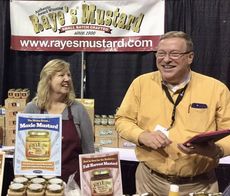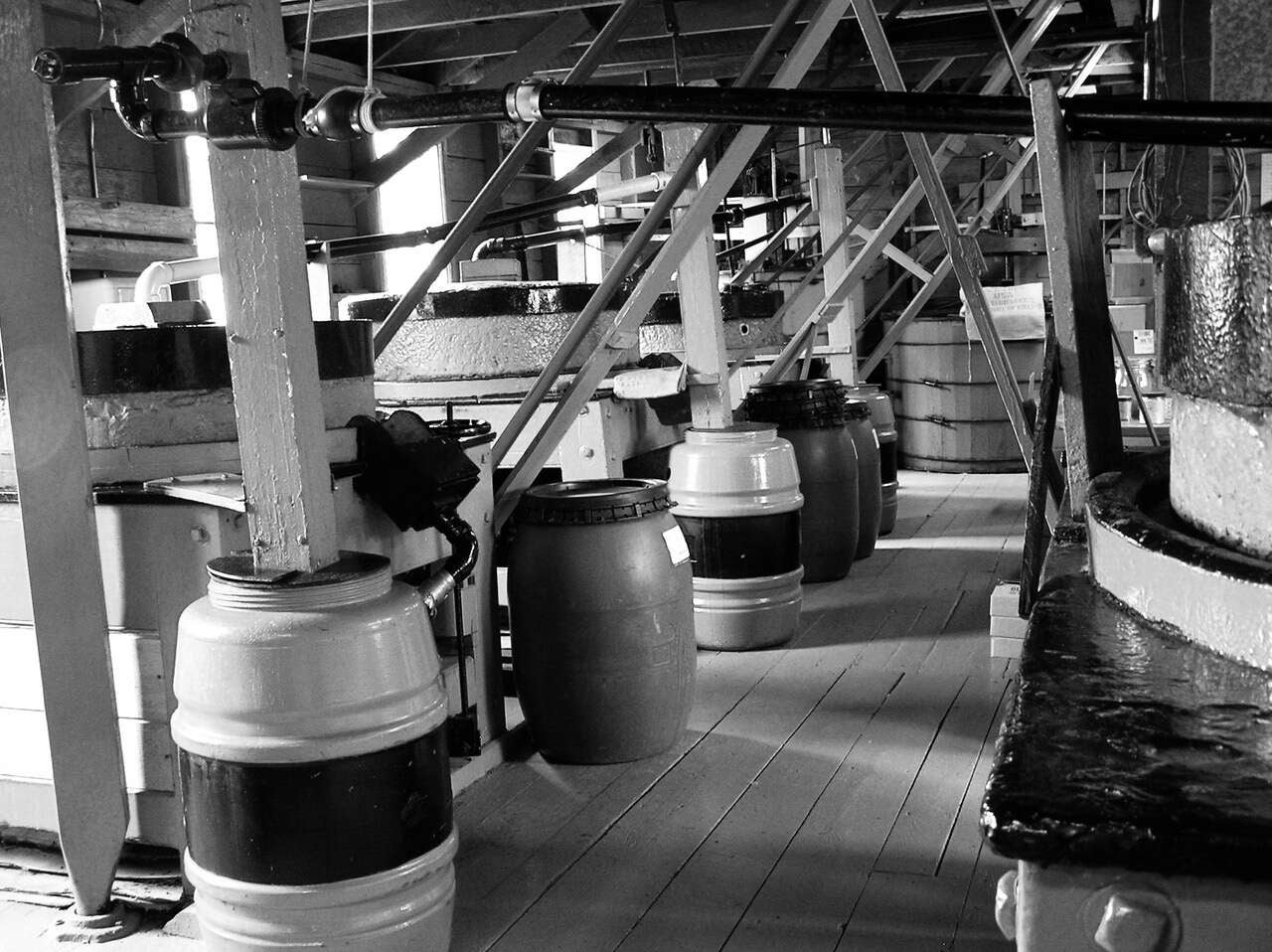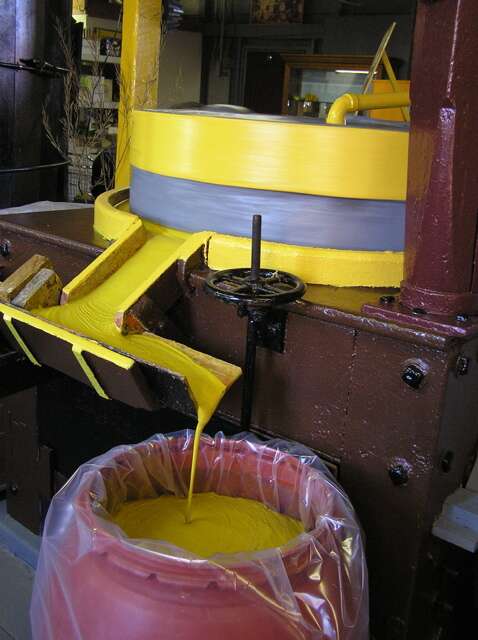
Eastport mustard mill-museum makes headway toward $2M renovation
 Courtesy / Raye’s Mustard Mill Museum
Seen here is a rough drawing of the planned museum. The existing building is the red structure at left. It would become an exhibit within the larger structure built around it.
Courtesy / Raye’s Mustard Mill Museum
Seen here is a rough drawing of the planned museum. The existing building is the red structure at left. It would become an exhibit within the larger structure built around it.
The planned overhaul of a unique cultural attraction in Eastport received a financial boost with a donation from the Bill and Joan Alfond Foundation.
The donation helped Raye’s Mustard Mill Museum in Eastport exceed $250,000 for the construction of a new building to house and preserve the historic working museum.
The foundation declined to cite the amount of its donation.
Creation of the museum is expected to cost around $2 million. Organizers hope to have it open by 2024.
Earlier this year, First National Bank helped jumpstart the project with a gift of $25,000. Other major contributions have come from Bangor Savings Banks and from DRC Holdings Inc.
“The reason we started this is that we feel an obligation to the history of the mill and its unique role in an industry that has vanished,” said Kevin Raye, who co-owns the mill with his wife Karen. “The mill has been part and parcel of the fabric of the community for as long as anyone has been alive.”

Last mustard mill
Raye's Mustard Mill, at 83 Washington St., was built in 1903 by J. Wesley Raye to supply mustard to the two dozen or so sardine canneries in Eastport and others along the coast of Maine.
J. Wesley Raye built the mill around a series of quartz grinding stones, imported from France, that are still used today as the last remaining stone-ground mustard mill in North America.

In 2005, Karen and Kevin Raye became the mill's fourth-generation owners and continued to use the massive quartz grindstones and other vintage equipment to produce and sell mustard.
Kevin is J. Wesley’s great-great-nephew. He is a former Maine state senator who represented Senate District 29 from 2004 to 2012.
The couple’s goal was to ensure the business would remain in Eastport. Since the acquisition, they’ve grown the business substantially with the help of online marketing and social media engagement. The company has won national mustard competitions, received recognition from regional and national media outlets, including features in national publications such as Martha Steward Living, O Magazine, Rachael Ray Every Day, and Yankee Magazine, and developed partnerships with craft beer companies and other food purveyors.
In 2017, Raye’s Mustard was named one of the “Top 10 Iconic Maine Products” in a Mainebiz’s Fact Book list.
The company offers over 30 mustard flavors.

Today, the traditional stone-ground mustard mill is the last remaining one of its kind in North America.
Working museum
The mill has also functioned as a working museum that, over the years, has drawn thousands of tourists annually to see the production process.
But a structural engineer’s report found the mill needed immediate and expensive restoration and preservation.
While the small family business could afford the cost of building a small manufacturing facility to continue making mustard, the costs of undertaking a restoration project that would preserve the working museum aspect of the old mill were daunting.
In 2018, the Rayes created a nonprofit museum to own and preserve the mill as a historical, cultural and educational asset.
J.W. Raye & Co Inc., doing business as Raye’s Mustard, remains a for-profit business and has entered into a long-term agreement with the nonprofit museum to continue producing mustard at the mill. The agreement ensures that Raye’s mustards will continue be made the old-fashioned way and that visitors will continue to be able to see the stone-ground process firsthand.
The museum owns the building and the land it sits on and has a controlling interest in the original grindstones.
A long-term operating agreement between the museum and Raye’s Mustard ensures the mill will continue producing Raye’s mustard, while providing a steady stream of income that will cover nearly all of the cost of maintaining the museum.
The Rayes said that, by entering into the arrangement, they are foregoing the opportunity to sell the mill building to another for-profit entity in the future and are limiting the future sale of J.W. Raye & Co. itself to a buyer who shares their commitment to maintaining and operating the business in its current location.
The nonprofit museum owns the building and the Rayes will also be foregoing future rental income from J.W. Raye & Co.
“Recognizing that the mill’s useful life is rapidly nearing an end, we knew we could simply build a small metal building to manufacture mustard, but we felt an obligation to honor and preserve the unique history of the old building and the rare Second Industrial Revolution machinery that has been maintained all these years,” said Kevin Raye.
Must-see
The facility has been closed to visitors since the pandemic. The Rayes said that, due to the aged condition of the building, they decided to postpone reopening it until the new building is complete.
They’re getting indications that the mill remains a must-see for visitors. The Rayes have a separate gift shop in Eastport.
“The number of people who come into our shop and want to tour the mill — incredible,” said Karen.
“They ask about it daily,” added Kevin.
The mill has been a tourist attraction for many years.
“People have been accustomed to visiting it in the past. They’ve read about it or heard about it and they come to Eastport to tour it,” Kevin continued.
The new construction will evoke the original building, “which for as long as anyone can remember has been a red shingled building,” he said. “We want the façade to be evocative of that traditional look of the mill.”
The new structure will not only be designed to enhance visitor experience but will also double the company’s production space.
“We have tens of thousand of people who visit the mill and one of the most common things people say is it reminds them of Willy Wonka’s chocolate factory,” said Kevin. “You have belts going around and pumping up and down and stones spinning and mustard flowing across the stones. Visually, it’s very exciting for people to see.”
The couple has also been interviewing former workers with the mill. They recently sat down with four retired men who worked at the mill at different times during the period form the 1950s until more recently.
Construction project
At an estimated cost of $2 million, the renovation and new construction would enhance the museum and provide visitors with education on the history and process of traditional stone-ground mustard-making.
The historical significance of the mill and its role in the sardine industry will be showcased in the museum. Plans call for displays of vintage photos, artifacts and documents. At the heart of the museum will be a production area featuring the historic gears, belts and central drive shaft that operate the quartz stones. An enclosed hallway with viewing windows along one side will give visitors a view of the quartz stones and vintage machinery.
The renovation includes a new building to be built over and around the existing original production facility, virtual tours for classrooms across Maine and the nation, a kitchen that could be used for nutrition classes and recipe sharing, an expanded gift shop, and a space for community meetings and events.
A vintage boxcar sitting on an abandoned rail siding adjacent to the mill will be incorporated into the museum as a theater where people can watch an educational video about the history of the and the role it played in Maine’s sardine industry.
$2M in annual impact
A 2019 economic analysis by Camoin Associates found that a one-time $2 million investment in the project could annually generate $2.2 million in sales at businesses throughout Eastport.
It’s expected the renovation will attract 25% more visitors; support 31 direct jobs in the community, representing more than $730,000 in earnings; and help to generate more than $76,000 in property tax revenue.
A long-term agreement with J.W. Raye & Co. will enable the mill to continue producing mustard while providing a steady stream of income to help offset the cost of maintaining the museum.
The investment would exceed what mustard sales alone could support.
The goal of the fundraising campaign is to secure charitable contributions and grants necessary to preserve the mill and enhance the museum experience for visitors.
The Rayes said they’re working toward fulfilling a 50/50 match needed to qualify for a U.S. Economic Development Administration grant for the project.
On top of donations, they’ve been approved for a loan that brings their total to date to $567,000 — about half the match needed.
They’re working with the Northern Maine Development Corp. on the application.
The goal is to break ground in 2023 and have the project competed in 2024.
The new building will be 16,527 square feet — more than twice the size of the current facility.
A goal is to expand the educational component of the museum.
“Over the years, we’ve had students come to visit the mill,” said Kevin. “We want to be able to expand that, not only with in-person visits, but also virtual visits. We envision having kids across Maine being able to experience a piece of Maine history.”
It’s expected that educational partnerships will include schools and the Maine Library Association, which has already connected the Rayes with its STEM educators program, said Karen.
If J. Wesley Raye were to return to the mill today, he would be able to pick up running it exactly as he did 100 years ago.
“We couldn’t just tear it down and build a little metal building to make mustard,” said Karen. “It would have been a loss to the community.”
For more information, click here or contact info@rayesmustardmillmuseum.org or Karen Raye at 207-853-6630.










0 Comments